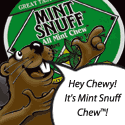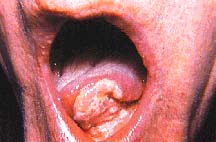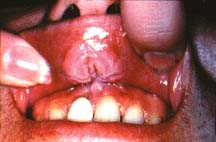
Healthy Substitute for Cigarettes and Chewing
Tobacco. Freshens Breath, Too!
Help A Friend Quit - Tell them about QuitCard.com
How To Help Someone Quit Chewing Tobacco
Why Do People Use Tobacco?
Cessation Techniques
Intervention Techniques
Where Can a Person Buy Mint Snuff?
$1 Samples Program
Prevention Is The Best Medicine
Why do people use
Tobacco?
Knowing why a patient uses tobacco helps identify what
method will help them quit. Some of the reasons are:
- Peer pressure- This seems to be one of the first reasons that kids especially start using tobacco. They usually first get it from a friend (or parent!) who urges them to try it and be like the "big kids". By the time the child goes to the store to try to purchase tobacco, many might have already been using it for several days or even weeks. Some of these kids say they need to display the "ring on their rear" in order to be accepted with some of their peers. In others, the circle on the back pocket is a coming-of-age or emancipation symbol, marking the passage to adulthood and "independent thinking".
- Social pressure and Association- Being in an environment that condones tobacco use (sports, bars, outings or any place they are around others who use it) can be a great motivator. Users are often able to quit for a significant length of time but begin again when they're around others who dip or smoke.
- Behavior- Some chewers have been "dipping" so long that they miss the ritual of opening the chew can, getting the "dip" and putting it in their mouth. The most common statement heard from these users is "I just miss something in my mouth" (i.e. oral gratification). Here they have a choice of either quitting "cold turkey" and dealing with the loss of the behavior or using an oral alternative while they cut down. Mint Snuff products are great for these people because it allows them to yield to the cravings of the behavior yet do so with a harmless product.
- Nicotine Addiction- There is a significant amount of nicotine in smokeless tobacco. Although many young users might not be addicted yet others get that way rather quickly. You might ask a user how long they have been using smokeless tobacco and how many cans a week they use to get an idea of possible levels of addiction (the range is one to three cans per week). Many of the questions asked of smokers apply to chewers to determine addiction levels. Many health professionals use the nicotine patch or nicotine pills with non-tobacco chew to help their nicotine-dependant patients.
- Salt Cravings- A typical can of smokeless tobacco contains over 1100 mg of salt. Some people not only suffer from nicotine withdrawal but also from salt cravings once they have quit using smokeless tobacco. These cravings might be confused with nicotine withdrawal.
Cessation techniques
Over the years, several smokeless tobacco cessation and prevention
techniques have been tried with varying levels of success. Some of them
include:
1. Education- One of the easiest and first lines of defense in cessation is to educate them on the dangers of tobacco. Give your patients literature from the American Cancer Society and the National Cancer Institute. We have some pamphlet and booklet suggestions in this web site. Posters, pamphlets and repeated reminders (i.e. intervention) from health professionals to their patients to not start using tobacco can be very influential. Encouraging and educating young people regarding non-tobacco use can also help that person become influential to their peers.
2. Quitting “Cold turkey”- People can and do quit chewing on their own. The health professional can be very helpful by encouraging quitting and giving support whenever possible. Chewers who have not been chewing very long are often successful with this method.
3. Chewing an alternative- Oral gratification "missing having something in my mouth", behavioral rituals and peer pressure are powerful influences to keep a person using smokeless tobacco. Here is where using healthy alternatives like Mint Snuff All Mint Chew or Pouches becomes so valuable. They allow the patient to continue the behavior and yield to whatever pressures keep them chewing but without the danger of tobacco. Some people can quit the behavior altogether after a few weeks, others take longer. If they quit and then feel the need to relapse, they can once again use Mint Snuff until the urge passes.
4. Titration- Some chewers who have strong nicotine withdrawal find it helpful to mix Mint Snuff with their tobacco. Some mix it with tobacco in a ratio of 1:4 one week, 1:3 the following week, 1:2 the next, 1:1 afterwards and finally to straight Mint Snuff. Click here to see Dr. Dan Laizure's method.
5. Alternating dips- Use tobacco and Mint Snuff alternately starting every other dip then gradually using Mint Snuff more and more until they don't use tobacco anymore.
6. Use of nicotine patches- For those chewers who display definite signs of nicotine withdrawal, doctors may consider the use of nicotine patches. Please check the latest information on suggested levels and age criteria for the use of patches with smokeless tobacco users.
7. Nicotine gum (Nicorette)- Studies have suggested that nicotine gum has not been very helpful in the cessation efforts. However, it is always worth a try if the patient wants to try it.
8. A prescription of wellbutrin (also called Zyban, a prescription anti-depressant pill) and the use of Mint Snuff Chew or Mint Snuff Pouches. A few un-named professional baseball players quit using this method.
Intervention
techniques
One of the most difficult things to deal with
when intervening with a patient about tobacco use is how and when to do it.
Until now, just telling a patient that they should quit chewing and not
offering any assistance or alternatives created some stress for the patient.
By offering an alternative, you can now establish a good relationship and
give the patient something to use in their own quitting process. When
combined into a comprehensive intervention plan, the overall effect towards
ultimate cessation can be quite effective. Here are some
other suggestions of how to deal with different patient ages:
- Be
consistent- Ask
every patient (especially adolescents) on each visit if they use
tobacco. If they don't, praise them for non-use and urge them to continue
avoiding tobacco. If they do chew, briefly inform them of the dangers of
tobacco, provide them literature and ask them if they want to quit.
Consistently asking someone about their tobacco use, especially young
adults, offers many opportunities for intervention.
- Kids from about 8yrs to
14yrs- These kids can be some of our best ambassadors of
health! You may want to ask them if they use tobacco in either a direct
or offhand manner: "I assume you are still not using tobacco, right?" or
"How do you feel about kids who are using chewing tobacco?" Ask their
opinion about tobacco use and if they know others who chew tobacco.
Whatever answer they give you can lead to an intervention opportunity:
- "No, I don't use tobacco"- Your response- "Wonderful, and I don't ever want you to begin.." Some have expanded this opportunity to ask if they know about the dangers of chewing tobacco so they might be able to tell one of their friends that does use tobacco. Ask if they would like to take some brochures on tobacco cessation to a friend. By intervening now, and letting them know how you feel about tobacco use, they can begin creating an anti-tobacco attitude before they are offered tobacco from a peer or another adult!
- "Yes, I have (or do) use chewing tobacco" - It can happen! The best you can do now is to find out how much they are using, why and then tell them briefly about the dangers of tobacco and that they should think about making their own decision to quit. There are no good reasons for them to be chewing tobacco. Offer them information about the dangers of tobacco and try to find out why they chew.
- Kids from about 14yrs to 21 yrs- Sometimes this is the toughest group to get to but represent the majority of new users. Asking if they would like to quit and then giving them information about the dangers of tobacco use are a great way to begin. If it is obvious that they are probably going to continue "dipping" anyway, you might want to suggest they do so with a healthy and harmless product like Mint Snuff and offer them a sample can.
- People 21 yrs and older- Many of the chewers in this age group have been chewing for many years. However, they may have also read about the dangers of chewing and/or have had their girlfriends or wives urge them to quit. For whatever reason, the health professional can again ascertain their desire to quit and offer an alternative if they need one. These people may need extra help with nicotine withdrawal.
- Kids from about 8yrs to
14yrs- These kids can be some of our best ambassadors of
health! You may want to ask them if they use tobacco in either a direct
or offhand manner: "I assume you are still not using tobacco, right?" or
"How do you feel about kids who are using chewing tobacco?" Ask their
opinion about tobacco use and if they know others who chew tobacco.
Whatever answer they give you can lead to an intervention opportunity:
- Find out if the patient is ready to quit- If the patient uses tobacco, tell them of your concern that they quit and ask them, “Do you want to quit?” If the answer is YES, continue with the cessation program. If their answer is NO, state “When you want to quit, let me know and we can help,” then go on with your normal procedures. Don't badger, just let them know that you care and you can help. Cessation experts report that unless a person is ready to quit, your chances of helping them is very low.
- Offer help- If your patient uses smokeless tobacco, ask them why they chew, and if they would be able to quit “cold turkey.” Ascertain whether or not they chew for social and/or behavioral reasons (i.e. “other guys do it...,” “only during baseball..,” “I need something in my mouth..,” etc.) If they feel like they want to continue chewing but need help with their behavior by using an alternative, offer Mint Snuff™ All Mint Chew™ or All Mint Pouches™.
Where Can You
Send Patients to Buy Mint Snuff?
 Mint
Snuff Chew™ and Mint Pouches™ are usually found in the tobacco section at
grocery and convenience stores. Many Krogers now carry Mint Snuff
Chew and Mint Snuff Pouches. Please ask your favorite store to carry it for
you or your patients. For a store near you
click here or
call 1.800.EAT.MINT * 1.800.328.6468 9a-5p Pacific Time Mon.-Fri.
Mint
Snuff Chew™ and Mint Pouches™ are usually found in the tobacco section at
grocery and convenience stores. Many Krogers now carry Mint Snuff
Chew and Mint Snuff Pouches. Please ask your favorite store to carry it for
you or your patients. For a store near you
click here or
call 1.800.EAT.MINT * 1.800.328.6468 9a-5p Pacific Time Mon.-Fri.
$1
Mint Snuff Pouches
Samples Available
Consumers may order samples of
Mint Pouches for $1.
If you are going to have a special promotion such as a health fair or other tobacco-related event, please call the Oregon Mint Snuff Company at 1.800.EAT.MINT * 1.800.328.6468 with your ideas. Practice SAFE SNUFF with Mint Snuff.



